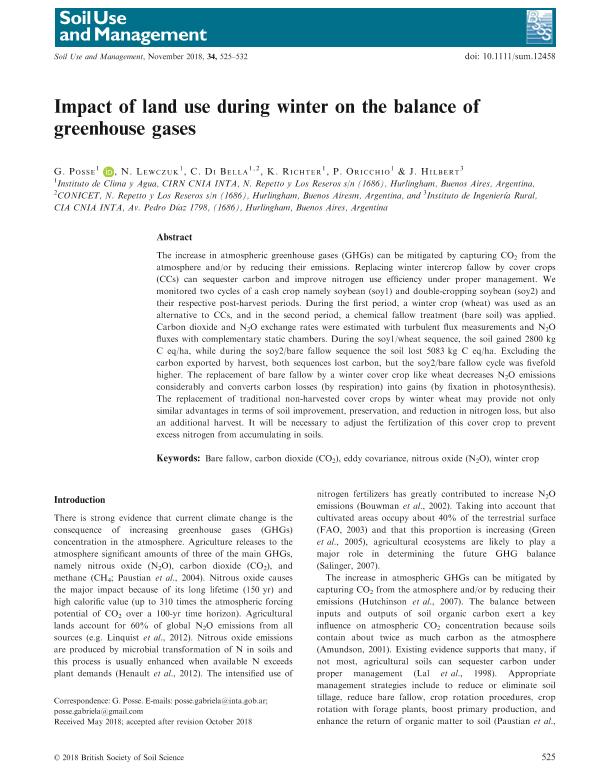Artículo
Impact of land use during winter on the balance of greenhouse gases
Posse Beaulieu, Gabriela; Lewczuk, Nuria ; Di Bella, Carlos Marcelo
; Di Bella, Carlos Marcelo ; Richter, K.; Oricchio, P.; Hilbert, J.
; Richter, K.; Oricchio, P.; Hilbert, J.
 ; Di Bella, Carlos Marcelo
; Di Bella, Carlos Marcelo ; Richter, K.; Oricchio, P.; Hilbert, J.
; Richter, K.; Oricchio, P.; Hilbert, J.
Fecha de publicación:
10/2018
Editorial:
Wiley Blackwell Publishing, Inc
Revista:
Soil Use And Management
ISSN:
0266-0032
Idioma:
Inglés
Tipo de recurso:
Artículo publicado
Clasificación temática:
Resumen
The increase in atmospheric greenhouse gases (GHGs) can be mitigated by capturing CO2 from the atmosphere and/or by reducing their emissions. Replacing winter intercrop fallow by cover crops (CCs) can sequester carbon and improve nitrogen use efficiency under proper management. We monitored two cycles of a cash crop namely soybean (soy1) and double-cropping soybean (soy2) and their respective post-harvest periods. During the first period, a winter crop (wheat) was used as an alternative to CCs, and in the second period, a chemical fallow treatment (bare soil) was applied. Carbon dioxide and N2O exchange rates were estimated with turbulent flux measurements and N2O fluxes with complementary static chambers. During the soy1/wheat sequence, the soil gained 2800 kg C eq/ha, while during the soy2/bare fallow sequence the soil lost 5083 kg C eq/ha. Excluding the carbon exported by harvest, both sequences lost carbon, but the soy2/bare fallow cycle was fivefold higher. The replacement of bare fallow by a winter cover crop like wheat decreases N2O emissions considerably and converts carbon losses (by respiration) into gains (by fixation in photosynthesis). The replacement of traditional non-harvested cover crops by winter wheat may provide not only similar advantages in terms of soil improvement, preservation, and reduction in nitrogen loss, but also an additional harvest. It will be necessary to adjust the fertilization of this cover crop to prevent excess nitrogen from accumulating in soils.
Archivos asociados
Licencia
Identificadores
Colecciones
Articulos(SEDE CENTRAL)
Articulos de SEDE CENTRAL
Articulos de SEDE CENTRAL
Citación
Posse Beaulieu, Gabriela; Lewczuk, Nuria; Di Bella, Carlos Marcelo; Richter, K.; Oricchio, P.; et al.; Impact of land use during winter on the balance of greenhouse gases; Wiley Blackwell Publishing, Inc; Soil Use And Management; 34; 4; 10-2018; 525-532
Compartir
Altmétricas



